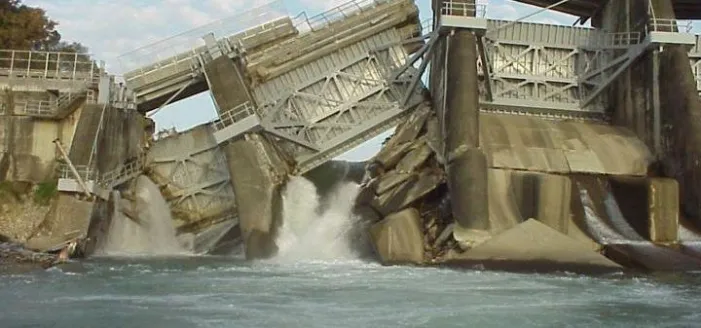Earthquakes and Dams : A Geological Study on Large Reservoirs
-Edited by Abbas Moustafa
Earthquake is defined as a sudden and rapid shaking of the earth caused by the breaking and shifting of rock beneath the Earth’s surface and it creates seismic waves, which can result in damages and failures on man-made structures constructed on the crust of earth. Dams and large reservoirs constructed in the area with high seismicity pose a high-risk potential for downstream life and property. It is clear that active faults, which are located close to dam sites, can induce to damaging deformation of the embankment as based on the instability of the dam and strength loss of foundation materials. Scientists have realized so much research for explaining the behavior of earth structures under seismic forces.
Large reservoirs can trigger earthquakes. This phenomenon is defined as Reservoir-induced Seismicity that is mainly dependent on excessive water pressure created in the micro-cracks and fissures in the foundation units under and near the reservoir. Water within the rock masses under huge hydrostatic pressure acts to lubricate faults, which are already under tectonic strain, but are prevented from slipping by friction of rock planes. It is clearly known that it mainly depends on the nature of structural geology and lithology of surrounding rocks. However, it is very difficult to accurately predict when and where reservoir-induced earthquakes will occur. ICOLD recommends that Reservoir Triggered Seismicity (RTS) should be considered for reservoirs having a depth of more than 100 m. USCOLD has reported that Reservoir Induced Seismicity (RIS) should be taken into account for reservoirs deeper than 80-100m.
![Figure 1.Buckling of river embankment lining after the 1999 Chi-Chi earthquake [32]](https://cdnintech.com/media/chapter/47738/1512345123/media/image1.png)
Figure 1. Buckling of river embankment lining after the 1999 Chi-Chi earthquake [32]
It is clear that a number of seismic events increases near reservoir areas of large dams after impounding sequence. The earthquake seismicity was first observed in 1929 for Marathon dam having 60 m high, Greece. An increase in seismicity was also seen in 1935 after the impounding of Hoover dam, which is a concrete arch dam with a height of 220 m. Up to now, RTS has been observed on over 100 dams in the world. The earthquake intensity has increased after the impounding of Keban Dam, which is the second largest dam of Turkey with a storage capacity of 31000 hm3 and 207 m in height from the foundation . Recently scientists believe the fact that the over one percent of reservoirs resulted to earthquakes which can damage or fail the main structure. It is not a negligible value that this mechanism should be considered by engineers in the design stage.
Damages due to RTS have been in two dams: (1) Koyna dam, which is a gravity dam having 103 m height in India. It was subjected to an earthquake with a magnitude of 6.3 in 1967. (2) Hsinfengkiang dam, which is a buttress dam having a height of 105 m in China. It was subjected to an earthquake with a magnitude of 6.1 in 1962. Researchers state that earthquakes were caused in their reservoirs by RTS. The substantial longitudinal cracks were developed near the crest for both dams. Both dams are still in operation after being strengthened.
The reservoir capacity is an important factor in triggering earthquakes as well as reservoir depth. The phenomenon of Reservoir Induced Seismicity (RIS) mainly conforms to the reservoir filling periods. It can also be seen for a reservoir after a certain time lag.
There are some important cases that strong earthquakes may affect a large area. Recent surveys indicate that there are at least 100 cases of earthquakes, which were triggered by reservoirs. The most serious case may be the 7.9-magnitude Sichuan earthquake on May 12, 2008, which killed an estimated 90,000 people. This earthquake has been related to the construction of the Zipingpu Dam, which is a 156 m high concrete-faced rockfill dam with a reservoir of 1 120 hm3. classified two types of earthquakes associated with reservoirs while explaining the complicated mechanisms of RTS after the 12 May 2008 Wenchuan earthquake in China: (1) The small magnitude earthquakes, which occur immediately after reservoir impounding or following sudden reservoir water level fluctuations are mainly related to stress adjustments in the foundation rock, collapse of karst caves and mining pits and mass movements, Earthquakes, which are caused by seismogenic faults passing through or adjacent to the reservoir area, are referred to as RTS. states that the initial stress state must already be close to failure so that a minor change in strength properties in a fault plane caused by water in the reservoir could trigger seismic events and the magnitude of RTS events may gradually increase until the main shock occurs. Authors have explained the mechanism of Wenchuan earthquake by the earthquake of a tectonic nature.
(Note -These are the abstracts of the book titled, EARTHQUAKE ENGINEERING- FROM ENGINEERING SEISMOLOGY TO OPTIMAL SEISMIC DESIGN OF ENGINEERING STRUCTURES borrowed with thanks to spread awareness among masses and to caution political decision-makers and planners. – Usha Rawat- The Admin)

